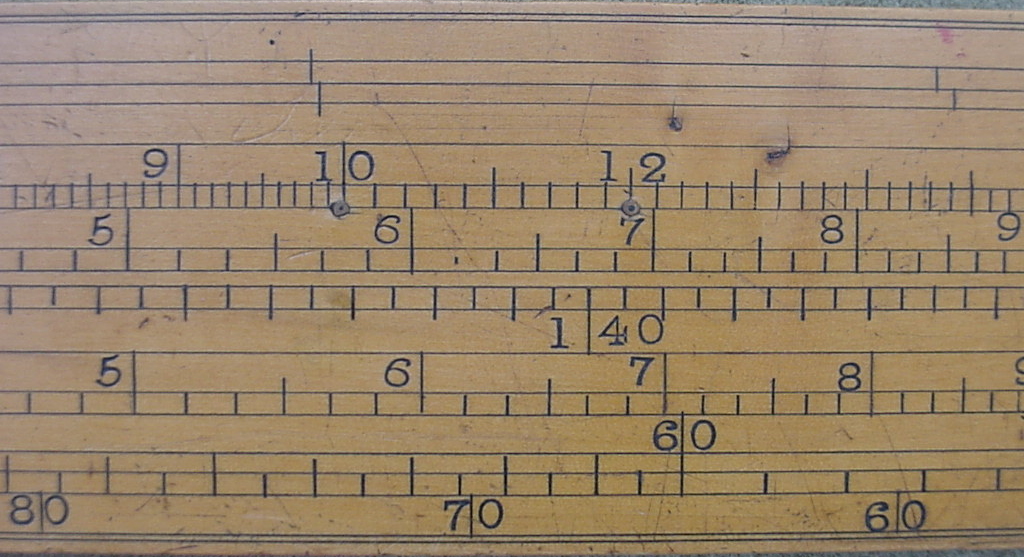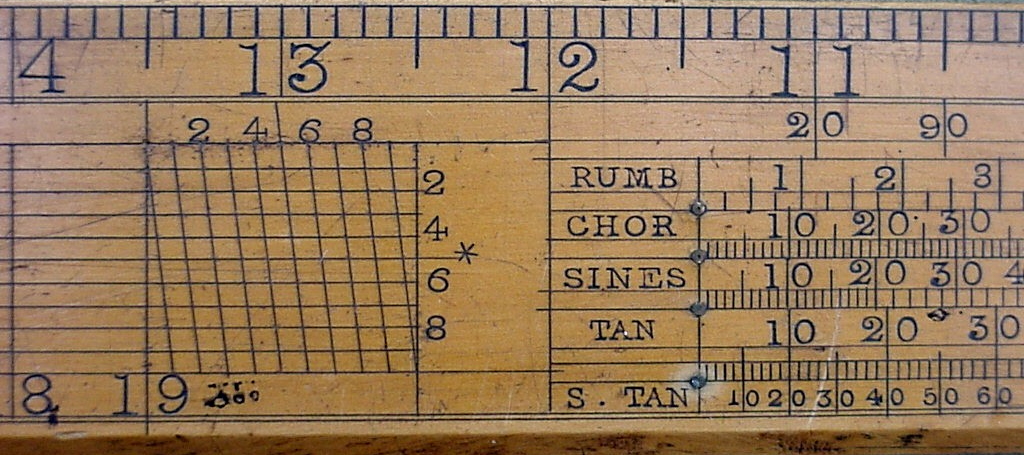1831–1843 Gunter Proportional Rule by Belcher and Bros, New York, New York.
The ever increasing importance of maritime trade and warfare created a need for more accurate navigation. This in turn required greater facility in calculation amongst captains and their officers. Following the publication of the first book of logarithms my Napier in 1614, Professor Edmund Gunter of Cambridge University was quick to prepare a graphical scale which laid out the number line in a manner where the length between each number was proportional to its logarithm. With this it would be possible with a pair of dividers to measure off logarithms of numbers, and thus add and subtract them to achieve multiplications and divisions relatively quickly and easily (although not particularly accurately given the dexterity required). Other scales, most notably those proportional to trigonometric values were also added. The result was the “Gunter Rule” which was still in use in the late nineteenth century and had by then been adapted for a variety of uses.
This two foot long Gunter Rule here is made by the American company Belcher and Bros, New York, New York and has the scales appropriate to navigation.
According to Philip Canon1 Thomas Belcher, who may have been a descendent of Zachariah Belcher (a Sheffield rulemaker 1839–1865) who most likely emigrated from England as an apprenticed rule maker. Canon notes that an 1860 Ken Roberts’ Reprint of an 1822 Belcher Brothers & Company Catalogue describes Thomas Belcher as of 1821 working at 145 Division Street in the 1822 New York Directory as a rulemaker. Roberts notes that Thomas Belcher’s brother William joined the firm in 1825 forming T. & W. Belcher at 141 Milbury Street later moving in 1832 to Water Street and operating as Belcher Brothers. In 1840 the business was at Platt Street and in 1851 moved again to 271 Pearl Street. Roberts reports that the sons joined in 1853 and the firm was then named Belcher Brothers & Company. It was from ~1831–1843 that the products of their work bore the mark “BELCHER BROS, New York, New York.”2
Roberts reports that Belcher Bros & Co. continued making rules until 1877 and that William Belcher continued to sell them until 1880 at 89 Chambers Street, New York City. The1860 Catalogue is reported by Canon to state ‘…the articles will continue to be made of the same uniform good quality, well seasoned and accurate, for which they have been celebrated ever since their first introduction, in the year 1821. The rules denominated Round Joint, being generally made of an inferior selection of Boxwood, although well seasoned, will not have the stamp of the firm upon them, but all others will be stamped “Belcher Brothers & Co., New York,” and may be relied upon as genuine.’3
1 Philip Canon II http://pactu.com/ viewed 1 May 2012 (↑)
2 Philip Canon II http://pactu.com/seven0610.2041/presentation1020.htm viewed 1 May 2012 (↑)
3 Canon http://pactu.com/ (↑)
Pages linked to this page
 This work by Jim Falk is licensed under a Creative Commons Attribution-NonCommercial-NoDerivs 3.0 Unported License Click on the logo to the left to see the terms on which you can use it.
This work by Jim Falk is licensed under a Creative Commons Attribution-NonCommercial-NoDerivs 3.0 Unported License Click on the logo to the left to see the terms on which you can use it.

